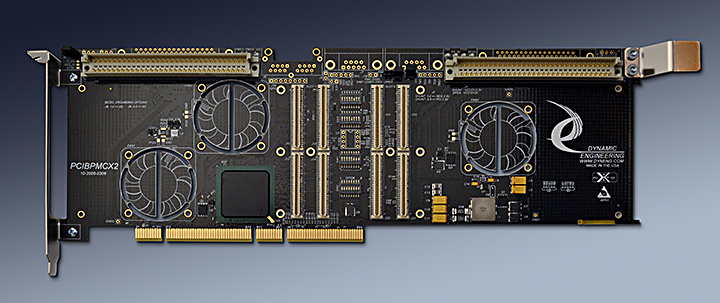








PCIBPMCX2
PCI to PMC Adapter / Carrier





















| Full length PCI card. |
|
| |
|
| 2 PMC Slots provided. |
|
| |
|
| PCI primary bus can operate at 133, 100, 66 or 33 MHz. Secondary side can operate at the same or lower frequency than primary side. User switch provided for clock selection, or automatic detection can be used. |
|
| Standard PCI byte lanes supported for byte, word and long access dependent on installed PMC. 64 or 32 bit operation from either bus supported by Bridge. |
|
| Bridge supports 133,100, 66 or 33 MHz operation. |
|
| Industry Standard 31154 Bridge register definitions. The bridge does not require any user set-up. PMC register definitions as defined by installed hardware. | |
| INTA, INTB, INTC, INTD routed to PCI connector from both PMC slots. Most PMC´s use one Interrupt level [INTA]. User switches allow independent mapping of the PMC interrupt request to the PCI connector. Slot 0 is usually mapped to INTA and slot 1 to INTB. In addition the interrupts can be routed [controlled with DIPswitch between the PMC positions to support local PrPMC control. |
|
| |
|
| +5, +12, -12V, regulated or PCI +3V supplied to PMC´s. |
|
| Primary side set by PCI bus. Secondary side set by user selection [shunt]. Regulated 3.3V or 5V via MOSFET to VIO mini-plane. |
|
| The PCIBPMCX2 has a cut-outs to support increased airflow over the PMC component side. Optional fan(s) with 4 mounting positions are available. |
|
| Front Bezel IO supported at PCI bracket. Jn4 "user IO" supported with either SCSI or DIN connectors. See Panduit for mate [120-964-455] or standard SCSI II connector. Optional support for Ethernet and Serial ports from PrPMC devices. |
|
| |
|
| PCI, PCI-X, PICMG 2.15 specification compliant |
|
| |
|
| |
|
| +3V, +5V, +12V, -12V and Busmode 1 [present] for each slot plus VIO. | |
| |
|
| 4 - 8 position switchs are provided to allow for configuration control and to select the primary and secondary clocking options. | |
| |
|
| Primary PCI JTAG connections are made to the Bridge. The PMC JTAG connections are tied to labeled headers. One header following the Altera standard and one compatible with Xilinx and other manufacturers. | |
| |
|
| Statement of Volatility |
| PCIBPMCX2 offers PCI-X and PCI speeds plus a second PMC slot for designs with more than one PMC. For local processing the rear slot can be used for a PrPMC with the IO or signal processing in the front slot. The Host computer can set-up operation, and then the PrPMC can use the local bus for high speed data transfer with the second PMC. | |
| |
|
| PCIBPMCX2 is competitively priced - more than a single slot carrier, and less than two carriers. Make use of existing PMC designs in PCI applications without paying for the expense of a new design and layout. Save PCI slots with two PMC´s in one location. Quantity discounts are available. |
|
| |
|
| The PCIBPMCX2 is easy to use. A plug and play interface to the PMC site. The Bridge can be configured with the user switches on board; eliminating any requirement for special software for the bridge itself. The PCIBPMCX2 has a bridge with Transparent and Non-Transparent modes. Standard drivers for the PMC´s can be used without any software required for the carrier. The board comes configured for a 66 MHz capable primary bus and 33 MHz secondary bus. In most cases the switches can be left with the factory settings. The manual contains clear directions for switch options. The engineering kit provides a good starting point for a new user. |
|
| |
|
| The PCIBPMCX2 is a popular board. We keep the PCIBPMCX2 in stock. Send in your order and in most cases have your hardware the next day - delivered to you via FedEx. |
|
| |
|
| The PCIBPMCX2 is a full size PCI board which conforms to the PCI mechanical and electrical specifications. Eliminate mechanical interference issues. The PCIBPMCX2 can be used in all full length PCI compliant slots. Please check that your computer has a full length slot with the proper PCI offset card guide support. |
|
| |
|
| The PCIBPMCX2 is PMC compliant per the IEEE 1386 specification. All Dynamic Engineering PMC Modules are compatible with the PCIBPMCX2. All other PMC Modules which are compliant with the PMC specification are compatible with the PCIBPMCX2. | |
| |
|
| The PCIBPMCX2 is PCI compliant. The PCIBPMCX2 can be expected to work in any PCI compliant backplane. The PCIBPMCX2 has been tested in multiple backplanes. |









